Just in Time
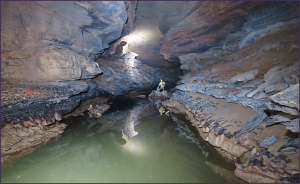
Fogelpole Cave, the longest cave system in Illinois. Photo courtesy Aaron Addison
By Todd Strole, Natural Areas Stewardship Program Manager for IDNR’s Division of Natural Heritage
Sinking streams, swallow holes, blind valleys, karst springs, slumps, sinkhole ponds, and sinkholes are likely terms you rarely hear in the Prairie State, unless you are in the sinkhole plain Natural Division of Southwestern Illinois. These geologic features formed in limestone in this part of Illinois are common and in fact, this area has the greatest density of karst features in Illinois.
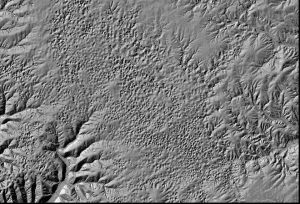
LiDAR image of the sinkhole plain in Monroe County, IL. Image courtesy Aaron Addison
There are an estimated 10,000 sinkholes in 1,225 square miles of the sinkhole plain and 142 known caves, including 3 of the longest in Illinois. The sinkhole plain extends the entire 25-mile length of Monroe County as a fairly continuous band up to 8 miles wide. LiDAR images can provide a great visual of the extent and density of sinkholes in the area. More information on this landscape can be found in The Sinkhole Plain: An Inventory of the Region’s Resources, but that is not what this story is about. This story is about dirt.
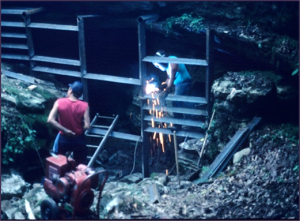
Construction of a gate at the main entrance to Fogelpole Cave. Photo courtesy IDNR
First, a little more context is required to set this story up. The largest and least disturbed cave system in Illinois is Fogelpole Cave near the southern edge of the sinkhole plain, in Monroe County. The cave and the area surrounding the main entrance has an interesting history, much of it, succinctly captured in a Washington University article published a few years ago. The cave supports a large and diverse animal population, including the Indiana bat, a federally endangered species. Several other bat species use the cave and a few hundred use the cave as an overwintering site. Another Federally endangered species, the Illinois cave amphipod, a small cave dwelling amphipod found nowhere in the world outside of a few caves in the sinkhole plain, also calls Fogelpole Cave home. The quality and rarity of these features led to a 27-acre site surrounding the cave entrance being dedicated as an Illinois Nature Preserve in 1989. The sensitive nature of the cave and its inhabitants necessitated some control over access to the cave and a bat friendly gate was installed in June of 1990. More recently, the recharge area (the watershed) for the cave system was designated a Class III, Special Resource Groundwater by Illinois EPA and the Illinois Pollution Control Board. This designation is reserved for ground water that is “demonstrably unique…or…vital for a particularly sensitive ecological system…or…groundwater that contributes to a dedicated nature preserve…”
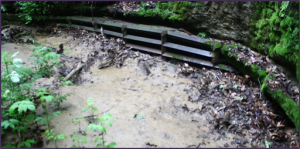
Entrance to Fogelpole Cave in May 2018, just prior to silt removal project. Photo courtesy Badger Daylighting
The primary cave entrance is located at the bottom of a large sinkhole. The cave gate is approximately 12 feet tall at its highest point and 26 feet wide. A small stream entering the sinkhole carries silt and debris which began to collect at the gate. Nearly 30 years later, the silt and debris had accumulated in front of the cave gate to the point that Natural Heritage field staff determined air flow for the cave was being significantly reduced, only about one foot at the top of the cave gate remained open. A decision was made, we were not going to allow the main entrance to one of the most significant cave systems in Illinois to close.
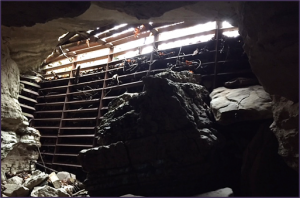 Terry Esker, in his new role as Regional Natural Areas Stewardship Coordinator for Division of Natural Heritage’s Southern Region, began working with staff within INDR and Illinois Nature Preserves Commission on a solution. The silt and debris had to be removed so air movement could occur and the cave could “breathe”. Air flow is critical for the overall health of cave ecosystems. Cave climate is important to the flora and fauna, and for karst processes within the cave. The temperature, humidity and air quality is largely controlled by the degree of air exchange with the outside environment. Historically, the landscapes associated with sinkholes were either forest or prairie communities and silt or debris were not a significant issue blocking cave entrances. However, modern land use that is primarily row crop agriculture and other human impacts have increased silt loads and debris entering the sinkholes.
Terry Esker, in his new role as Regional Natural Areas Stewardship Coordinator for Division of Natural Heritage’s Southern Region, began working with staff within INDR and Illinois Nature Preserves Commission on a solution. The silt and debris had to be removed so air movement could occur and the cave could “breathe”. Air flow is critical for the overall health of cave ecosystems. Cave climate is important to the flora and fauna, and for karst processes within the cave. The temperature, humidity and air quality is largely controlled by the degree of air exchange with the outside environment. Historically, the landscapes associated with sinkholes were either forest or prairie communities and silt or debris were not a significant issue blocking cave entrances. However, modern land use that is primarily row crop agriculture and other human impacts have increased silt loads and debris entering the sinkholes.
IDNR estimated that over 2000 cubic feet of silt, originating primarily from adjoining properties, had accumulated at the cave entrance. Fogelpole sinkhole is large, steep, with forested slopes – factors making it impossible to access to the bottom of the sinkhole where the silt was located with traditional heavy equipment such as track hoes. IDNR wanted to minimize impacts to the natural community surrounding the sinkhole, so other methods had to be explored. As staff began searching for solution to this challenge, a casual conversation with someone in the concrete business led to the consideration of hydro-excavating the silt from the sinkhole. Hydro-excavating uses a truck mounted vacuum system to vacuum material into the truck through flexible tubes or pipes for off-site disposal. A high-power pressure washer is used to break up the material and then it is sucked up the hose/pipe to the vacuum truck as slurry – in simple terms, a monstrous shop-vac.
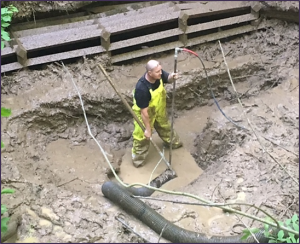
The first day of silt removal. A small “dam” of material was left along the gate as the project progressed to minimize the amount of silt and debris re-entering the cave. Photo courtesy Terry Esker
Badger Daylighting, a hydro-excavating company in Granite City, IL, was contacted to determine if the removal of the silt and debris using hydro-excavating was even an option. After examining the project site, Badger Daylighting indicated that they would be able to do the project and in June 2018, the silt removal project began. The first day was consumed with equipment set up including 240 feet of six-inch PVC pipe that ran from the bottom of the sinkhole uphill to the top of the hill where the vacuum trucks were parked, nearly 100 feet of vertical lift. The Badger crew began removing silt and debris on the second day and completed the removal of nearly 2500 cubic feet of silt and debris on the fifth day.
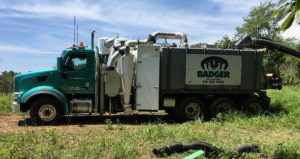
Vacuum truck at the top edge of the sinkhole containing the entrance to Fogelpole Cave. Photo courtesy Todd Strole
The silt and debris that was removed was transported and deposited on adjacent property owned by Clifftop, a local land trust. IDNR appreciates Clifftop allowing the silt to be deposited in a highly disturbed area on their property. Benjamin Koonce, Area Manager for Badger Daylighting indicated that this is the first time that his crew had been involved in a natural area restoration project. He said, “The crew really enjoyed this type of work. It is neat to know that the cave is not going to close up and the animals living in the cave can continue to use it.”
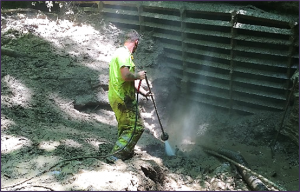
Using the power washer to create a slurry that can be vacuumed to the truck. Photo courtesy Todd Strole
We believe this is the first time the hydro-excavating was used to remove silt and debris blocking a cave entrance in Illinois. Hydro-excavation provides options for natural resource managers to remove silt and debris from high quality sites that are inaccessible to traditional heavy equipment with minimal impacts to the natural communities. This process could also be applied to other projects that aren’t necessarily rare or high-quality sites but are inaccessible with traditional heavy equipment. Overall, the hydro-excavating project was completed with minimal impacts to the cave and sinkhole community and other natural communities at Fogelpole Cave Nature Preserve. IDNR and Illinois Nature Preserves Commission are working with the adjoining landowners to reduce siltation through improved conservation and agricultural practices.
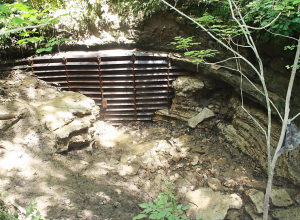
The silt removal completed, the cave opening appears as it did nearly 30 years ago. Photo courtesy Badger Daylighting
It could be argued that Fogelpole Cave, in the top 100 longest caves in US (currently #51), with a main passage averaging 40 ft. wide and 20 ft. high and having nearly 15 miles of mapped passages may provide the most remote wilderness in Illinois. The darkness, silence, the physical and technical difficulty in reaching many areas, the time to reach them and the relatively undisturbed nature of the cave – all combine to create a unique and special place.
Many thanks are due those staff in the Department to see the need, find the solution, and fund the project to give new life to this special place – just in time.
About the author: Todd Strole is the Natural Areas Stewardship Program Manager for IDNR’s Division of Natural Heritage. Todd has B.S. and M.S. degrees in biology from Eastern Illinois University and Illinois State University respectively and nearly 30 years of experience in natural resource management with The Nature Conservancy and IDNR.
This article was originally published in the June 30, 2018 issue of @ORC , which is a weekly publication by the IL Department of Natural Resources Office of Resource Conservation about exciting and wonderful things ORC staff are doing throughout Illinois. It has been reprinted here with the permission of the ORC and Mr. Strole.
Clifftop, a local nonprofit organization, is focused on preserving and protecting area blufflands.
A version of this article appeared in the August 3, 2018 edition of the Monroe County Independent.
©2018 all content rights reserved Clifftop NFP
Comments are currently closed.
